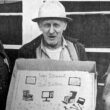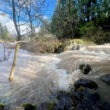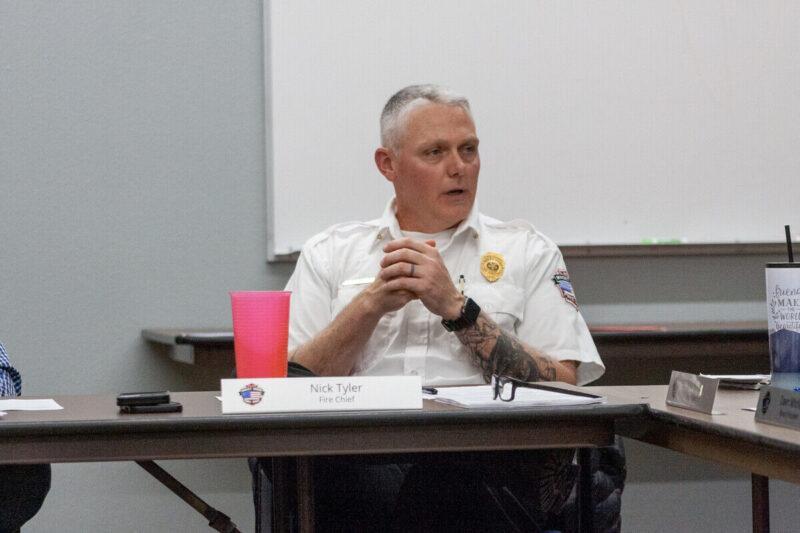Kristy Tallman
The Sweet Home Fire and Ambulance District (SHFAD) is embarking on a proactive initiative to enhance its emergency response capabilities by proposing a bond aimed at acquiring crucial equipment and supporting operational requirements.
Explaining the rationale behind the bond proposal, SHFAD Chief Nick Tyler sheds light on the unique funding structure of the district. He remarks, “We aren’t entitled to a lot of other taxing revenue. So we’re very confined to property taxes to support our operations,” Tyler said, emphasizing the district’s necessity of seeking alternative funding sources.
He added, “At some point, leaders are kind of forced to come up with alternative funding sources, especially for equipment.”
Highlighting the previous funding model, Tyler reflected on the district’s past endeavors to secure operational levies for staffing needs. However, concerns arose regarding the potential impact of levies on property tax compression, affecting other essential services such as the police department and county sheriff’s office.
He explained, “If we would have gone out for a levy, it would have impacted how much the city gets for their levy for the police department.”
In response to these challenges, the SHFAD opted to pursue a bond specifically tailored for equipment acquisitions. Tyler underscored the strategic significance of this shift, stating, “We did switch gears…decided to go to equipment bond for multiple reasons.”
The proposed bond seeks to address a range of pressing equipment needs, including the acquisition of advanced firefighting apparatuses, specialized gear for firefighters, and facility upgrades. Tyler stated, “We have some big serious equipment issues that we need to address. We don’t have the ability to address that in-house with our budget.”
As the proposal moves forward, community involvement and support will play a pivotal role in determining its success. Tyler encourages residents to engage in the decision-making process, affirming, “It’s important for the community to know, we’re all kind of trying to fund out of the same pot.”
In addition to addressing critical equipment needs, Tyler elaborated on specific items the bond aims to fund, emphasizing the urgency of these acquisitions. “We need to replace two of our older ambulances.”
He further expressed the vital role ambulances play in the district’s operations, particularly given the high mileage they accumulate and the essential service they provide to the community.
“We’re currently averaging somewhere between 5000 to 6000 miles a month on our first-out ambulance. So that’s a real need. And we’ve had multiple ambulances out at once. So if one goes down, that affects the community. So we really need to do that,” said Tyler.
Tyler explained ambulances on the low side are $315,000 to $375,000 for one ambulance. “So you can see how that’s a big hit to the budget, and we need to buy two of those.”
He stated they would not be going for the lowest end versions but would be focusing on mid-priced units to ensure the capabilities would be lasting and efficient for the needs of the district.
Tyler also highlights the need for updating the district’s aging radio system, stressing its critical role in ensuring effective communication during emergencies. He made clear, “My primary focus is for our firefighters to be able to talk to each other or talk to dispatch, not only on a fire scene,” said Tyler, “but they’re up on highway 20 Cascadia or beyond on a rescue or something like that.”
Upgrading the radio system is essential for enhancing firefighter safety and operational efficiency, particularly in remote areas where communication challenges are more pronounced. The estimated cost for upgrading the radio system is $750,000, which includes the purchase of new radios and infrastructure improvements.
Tyler emphasized that despite strong collaborative efforts with the county on infrastructure, there are persistent challenges affecting radio communication. He noted ongoing discussions at county fire board meetings aimed at improving infrastructure, including repeaters, cell and radio antennas.
According to Tyler, the county is also doing things like looking for extra radio channels the district can use because call volumes have increased dramatically.
The need for additional radio channels to manage increasing call volumes was stressed, with Tyler underscoring that such issues are not unique to their district but are being faced by neighboring areas as well. He emphasized the strain on the existing system which is now overwhelmed by the volume of incidents, leading to communication difficulties, especially during simultaneous emergencies.
“We’re dealing with call volumes that we’ve never seen before. Lebanon’s dealing with call volumes they’ve never seen before. We’re running. We’re as busy as we’ve ever been.”
When the system was designed years ago Tyler stated there were three radio frequencies, “We overwhelm that weekly. There’s some types of major incidents that are happening at the same time. You can imagine if Lebanon is running a fire, and we’re trying to run a fire or car accident or rescue, and we’re trying to utilize the same radio frequency, they don’t work, so they are building additional frequencies to increase the capacity of our radio communication.”
Tyler also expressed concerns about the limitations of outdated equipment, including 20-year-old radios in apparatuses, which hamper effective communication during emergencies. He highlighted the urgent need to update these systems to ensure firefighter safety, citing instances where unreliable communication poses risks to personnel inside fires or other hazardous situations.
“We have to focus on what we can control. And that’s the biggest thing since I’ve taken over that keeps me up at night is our inability to effectively communicate on incidents, and that’s on 20 year old radios.”
He also stated the radios that are in the apparatus are worn down. “They don’t perform as effectively as the new systems. They’re just old. So updating that’s a huge priority for me. And I would talk to that as if that’s firefighter safety. If we have somebody inside a fire, I want to know if something happens, and they’re uncomfortable or trapped or they get hurt, they can tell somebody and radio that communication out.”
Despite efforts by multiple radio companies to address these issues, the consensus remains that equipment upgrades are necessary. The estimated cost for updating the radio system, approximately $750,000, includes investments in new radios and infrastructure improvements.
A portion of the radio budget is allocated for a paging system, intended to enhance alerting mechanisms for volunteers and off-duty personnel, supplementing existing cell phone-based systems with more reliable communication channels.
“We have a very low number in our volunteer system. It wasn’t always that way, many years ago we had 50. We’re down about 15 right now. So as the chief, it’s important for me that if we have an incident, everybody is aware that we have an incident. And if they’re available to come they come.”
Tyler said currently they use Active 911, which is a cell phone based alerting system, but stated it comes with all the problems that cell phones come with such as coverages, updates and just what people do with their phones at night.
Also discussed was the necessity of replacing two type six brush rigs used for responding to wildland urban interface incidents. He explains, “With the recent fires that we had in 2020 and every year since really, we respond to the wildland urban interface a lot more than we did a decade ago.”
These specialized vehicles are crucial for navigating rugged terrain and enhancing firefighting capabilities in remote areas.
Tyler said, “In our area, they are a lot more maneuverable, they can get up and down logging roads a lot better than big engines can, they can just do a lot more stuff. And we need to replace two of those, or we need to buy two of those.”
He continued, “I’m not going to surplus the two that we need to replace because I think they still have a place in our system and continue to use them. We’ll use them, it’ll just be in a different role. I don’t believe that they need to be out on the front lines because they are old and tired.”
Furthermore, Tyler discusses the importance of acquiring a chipper to support the district’s wildfire risk reduction efforts. He explains, “That allows us the capacity to go out and reduce fuels in our area.”
Tyler discussed the bond at the board meeting on Feb. 20, where he asked the board to support his bond proposal.
He stated to the board, “Looking at numbers at the $0.47 cents is kind of a comfortable number, it’s not asking for too much. And it’s not limiting ourselves on the back end of the bond. So $0.47 cents of $1000. If a house was an average of $275,000, we’re asking for $129.25 on a bond for that property owner.”
Tyler explained their last bond which just expired was $0.37 cents/$1000 for seven years.
“If you compare that to our last bond, that we just expired, it paid off at $0.37/$1000. So the difference between the $0.37 cents to the $0.47 cents is $12.70/$5,000 assessed value is $27.50 a year. I did break that down to a month and it’s $2.29. I feel comfortable. I know, times are tight for everybody. I feel they [the community] will feel really comfortable at $0.47 cents $1000 on a seven year bond that we’re protecting the interest of the district as well as being mindful of everybody’s bottom dollar.”
Board members approved Tyler’s proposed bond by unanimous vote and will look for votes at the May 21 primary election to approve or deny the bond.





